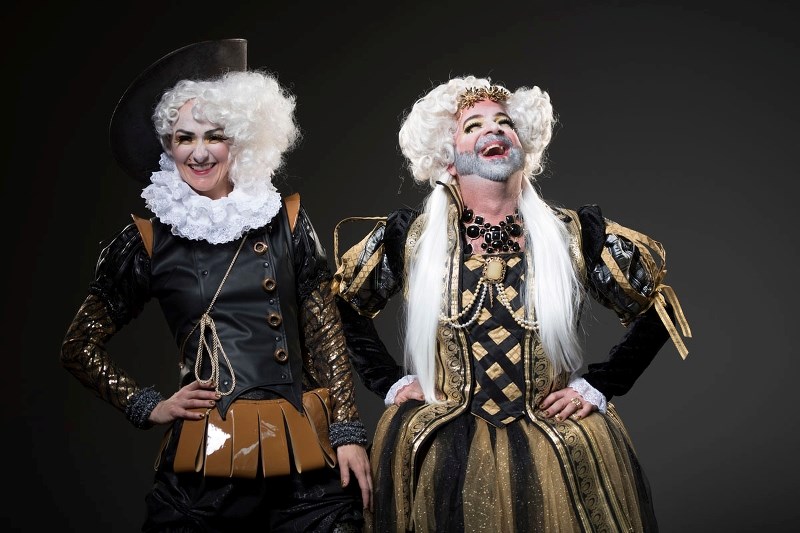“Do you dare to be who you really are?” Maybe if I were royalty. As former Olympian Bruce Jenner recently makes headlines for his gender re-assignment in a modern climate championing equality and civil rights, the topic is timely (if not “timeless”) and deserving of further exploration.
In the small, dim Westbury Theatre at the ATB Financial Arts Barns, the drag-dressed pair quietly wander the stage, pausing to pose. As the audience settles, the pre-recorded voices buzzing in the darkness start to become clear. There are interviews of people playing from the speakers, mostly from the LGBT community relating their experiences of gender, transition, isolation, and the resulting angst.
It is modern “outside-of-the-box” methods in a bare-bones setting that highlight the self-proclaimed “collage” and “sensory” aspect of Per Brask’s Christina/Philippe. A lot of care is put into communicating the play on many different levels.
Rather than being bound by theatrical tradition, the cast has taken liberties in order to be heard and remembered. By uniquely challenging the norm and infusing a flamboyance barely constrained within the minimalist design, the production has successfully matched its subject matter in the visual sense.
Kristi Hansen and Trevor Schmidt fictionally clash for a short hour as history’s “Queen Christina” and “Philippe D’OrlĂ©ans,” two non-fictional figures of royalty infamous for their gender-bending.
However, if that wasn’t post-modern enough, the interviews return to serve a role more important than filler for scene transitions. The cast admitted in-show they were merely conduits for the real thing and were naturally nervous in venturing into this concept.
This constant time-travel between fiction and present reality via audio excerpt helps to break the pace, but requires slight mental book-marking. You have to be able to match the relating voice to the moment it started or ended.
The playwright and cast have included their own personal views among the audio bites, but there are no doubts for whom this play is for. The music is setting-appropriate yet manages to capture pleasing Lady Gaga-inspired levels of empowerment through violin and harpsichord.
The play is written as chance encounter between two polar opposites who recognize their similarities, but struggle with their differences. Having to be naturally defensive and hardened in order to stay true to themselves (even as royalty) only served to drive two people of similar circumstances further apart.
It instantly reminded me of a Modern Family episode where the token male gay couple meet a lesbian couple through their children fighting in school. I don’t think I’m in a minority when I first mistakenly assume an inherent camaraderie united through similar ordeals.
The LGBT community may rally together, but they are still separate individuals. Identities naturally clash, especially if you’ve had to rebuild and temper your own identity through hardship or discomfort. The timeless conflict between the traditional masculine and feminine psyche continues, regardless of the perceived gender, sexuality, or cause.
The play may have set out to break pre-conceptions with its artistic license, but it also unavoidably implied some of its own. Internalized misogyny was presented and explained as a motivating factor for Christina in one of the scenes while most of the other political undertones are at least subtle enough to be hidden and enjoyed under basic morality.
Studying the individuals these characters are inspired from makes you realize that they are just that; inspired. In becoming fictionalized, the real queen and duke have had their identity somewhat hijacked in terms of context. No amount of personality or pizzazz will change that these people were only allowed to be who they are because of royalty.
There was no mention of the Swedish king who had loved his daughter when the palace was set on having a son. Instead of being confined and oppressed, Christina gladly accepted and excelled in her training as a boy king. “Are we like this because we are royalty? No!” shouts Christina.
As brother of the Sun King Louis XIV, Philippe II had a target on his back as most potential hereditary successors usually do. Yet this Duke of Orleans was able to remain safe and achieve many successes as regent due to his open and active homosexuality. While he sired children, his true preference was ultimately irrelevant, if not convenient for the court.
While united in theory, these historical figures likely differ in practice from modern transgender and gender queer advocates. Just how far “outside” is an outsider when he or she is a close member of “god’s representative” ruling family? Are they truly as strong and independent as someone from our time who likely risks becoming outcast and penniless by coming out to their family and society? While their similarities are initially unified, the contrast is there.
The Northern Light Theatre hosts Christina/Philippe until May 9. The 75 minutes just fly by.
Review
Christina/Philippe<br />Runs until May 9<br />Westbury Theatre<br />ATB Financial Arts Barns<br />10330 - 84 Ave.<br />Tickets: Call 780-409-1910




